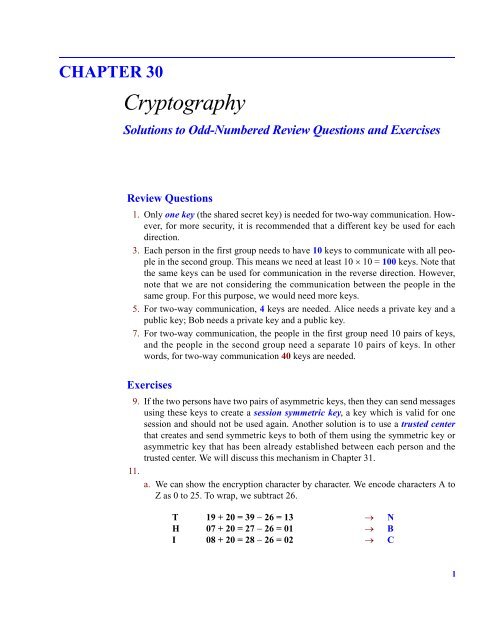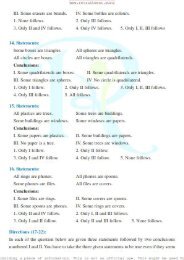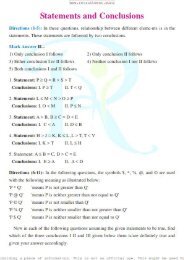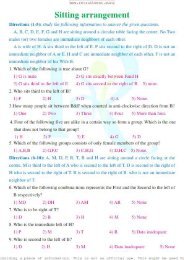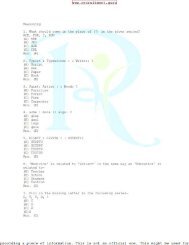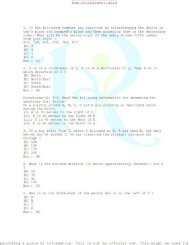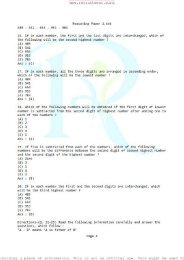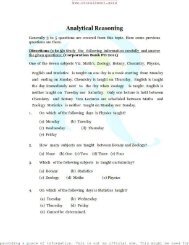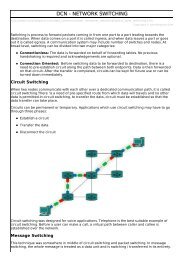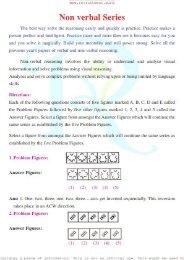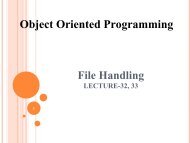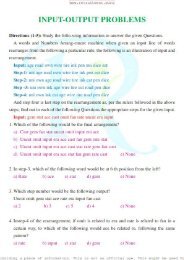SolStd30
Create successful ePaper yourself
Turn your PDF publications into a flip-book with our unique Google optimized e-Paper software.
CHAPTER 30<br />
Cryptography<br />
Solutions to Odd-Numbered Review Questions and Exercises<br />
Review Questions<br />
1. Only one key (the shared secret key) is needed for two-way communication. However,<br />
for more security, it is recommended that a different key be used for each<br />
direction.<br />
3. Each person in the first group needs to have 10 keys to communicate with all people<br />
in the second group. This means we need at least 10 × 10 = 100 keys. Note that<br />
the same keys can be used for communication in the reverse direction. However,<br />
note that we are not considering the communication between the people in the<br />
same group. For this purpose, we would need more keys.<br />
5. For two-way communication, 4 keys are needed. Alice needs a private key and a<br />
public key; Bob needs a private key and a public key.<br />
7. For two-way communication, the people in the first group need 10 pairs of keys,<br />
and the people in the second group need a separate 10 pairs of keys. In other<br />
words, for two-way communication 40 keys are needed.<br />
Exercises<br />
9. If the two persons have two pairs of asymmetric keys, then they can send messages<br />
using these keys to create a session symmetric key, a key which is valid for one<br />
session and should not be used again. Another solution is to use a trusted center<br />
that creates and send symmetric keys to both of them using the symmetric key or<br />
asymmetric key that has been already established between each person and the<br />
trusted center. We will discuss this mechanism in Chapter 31.<br />
11.<br />
a. We can show the encryption character by character. We encode characters A to<br />
Z as 0 to 25. To wrap, we subtract 26.<br />
T 19 + 20 = 39 − 26 = 13 → N<br />
H 07 + 20 = 27 − 26 = 01 → B<br />
I 08 + 20 = 28 − 26 = 02 → C<br />
1
2<br />
S 18 + 20 = 38 − 26 = 12 → M<br />
I 08 + 20 = 28 − 26 = 02 → C<br />
S 18 + 20 = 38 − 26 = 12 → M<br />
A 00 + 20 = 20 → U<br />
N 13 + 20 = 33 − 26 = 07 → H<br />
E 04 + 20 = 24 → Y<br />
X 23 + 20 = 43 − 26 = 17 → R<br />
E 04 + 20 = 24 → Y<br />
R 17 + 20 = 37 − 26 = 11 → L<br />
C 02 + 20 = 22 → W<br />
I 08 + 20 = 28 − 26 = 02 → C<br />
S 18 + 20 = 38 − 26 = 12 → M<br />
E 04 + 20 = 24 → Y<br />
The encrypted message is NBCM CM UH YRYLWCMY.<br />
b. We can show the decryption character by character. We encode characters A to<br />
Z as 0 to 25. To wrap the negative numbers, we add 26.<br />
N 13 − 20 = −07 + 26 = 19 → T<br />
B 01 − 20 = −19 + 26 = 07 → H<br />
C 02 − 20 = −18 + 26 = 08 → I<br />
M 12 − 20 = −08 + 26 = 18 → S<br />
C 02 − 20 = −18 + 26 = 08 → I<br />
M 12 − 20 = −08 + 26 = 18 → S<br />
U 20 − 20 = 00 → A<br />
H 07− 20 = −13 + 26 = 13 → N<br />
Y 24 − 20 = 04 → E<br />
R 17 − 20 = −03 + 26 = 23 → X<br />
Y 24 − 20 = 04 → E<br />
L 11 − 20 = −09 + 26 = 17 → R<br />
W 22 − 20 = 02 → C<br />
C 02 − 20 = −18 + 26 = 08 → I<br />
M 12 − 20 = −08 + 26 = 18 → S<br />
Y 24 − 20 = 04 → E<br />
The decrypted message is THIS IS AN EXERCISE.<br />
13. We can, but it is not safe at all. The best we can do is to change a 0 sometimes to 0<br />
and sometimes to 1 and to change a 1 sometimes to 0 and sometimes to 1. It can be<br />
easily broken using trial and error.
15. Input: 111001 → output: 001111<br />
17.<br />
a. Input: 1 1 0 0 1 0 → output: 0 1<br />
b. Input: 1 0 1 1 0 1 → output: 0 0<br />
19.<br />
a. Input: 1011 (the leftmost bit is 1), the output is: 110<br />
b. Input: 0110 (the leftmost bit is 0), the output is: 011<br />
21. We can follow the process until we find the value of d. For the last step, we need to<br />
use an algorithm defined in abstract algebra. We don’t expect students know how<br />
to do it unless they have taken a course in abstract algebra or cryptography.<br />
a. n = p × q = 19 × 23 = 437<br />
b. φ = (p −1) × (q −1) = 18 × 22 = 396<br />
c. e = 5 d = 317<br />
We can check that e × d = 5 × 317 = 1 mod 396<br />
23. Bob knows p and q, so he can calculate φ = (p − 1) × (q − 1) and find d such that d<br />
× e = 1 mod φ. Eve does not know the value of p or q. She just knows that n = p ×<br />
q. If n is very large (hundreds of digits), it is very hard to factor it to p and q. Without<br />
knowing one of these values, she cannot calculate φ. Without φ, it is impossible<br />
to find d given e. The whole idea of RSA is that n should be so large that it is<br />
impossible to factor it.<br />
25. The value of e = 1 means no encryption at all because C = P e = P. The ciphertext is<br />
the same as plaintext. Eve can intercept the ciphertext and use it as plaintext.<br />
27. Although Eve can use what is called the ciphertext attack to find Bob’s key, she<br />
could have done it by intercepting the message. In the ciphertext attack, the<br />
intruder can get several different ciphertexts (using the same pair of keys) and find<br />
the private key of the receiver. If the value of the public key and n are very large,<br />
this is a very time-consuming and difficult task.<br />
29. Nothing happens in particular. Assume both Alice and Bob choose x = y = 9. We<br />
have the following situation with g = 7 and p = 23:<br />
R1 = 7 9 mod 23 = 15<br />
R2 = 7 9 mod 23 = 15<br />
Alice calculates K = (R2) 9 mod 23 = 15 9 mod 23 = 14<br />
Bob calculates K = (R1) 9 mod 23 = 15 9 mod 23 = 14<br />
3
4


